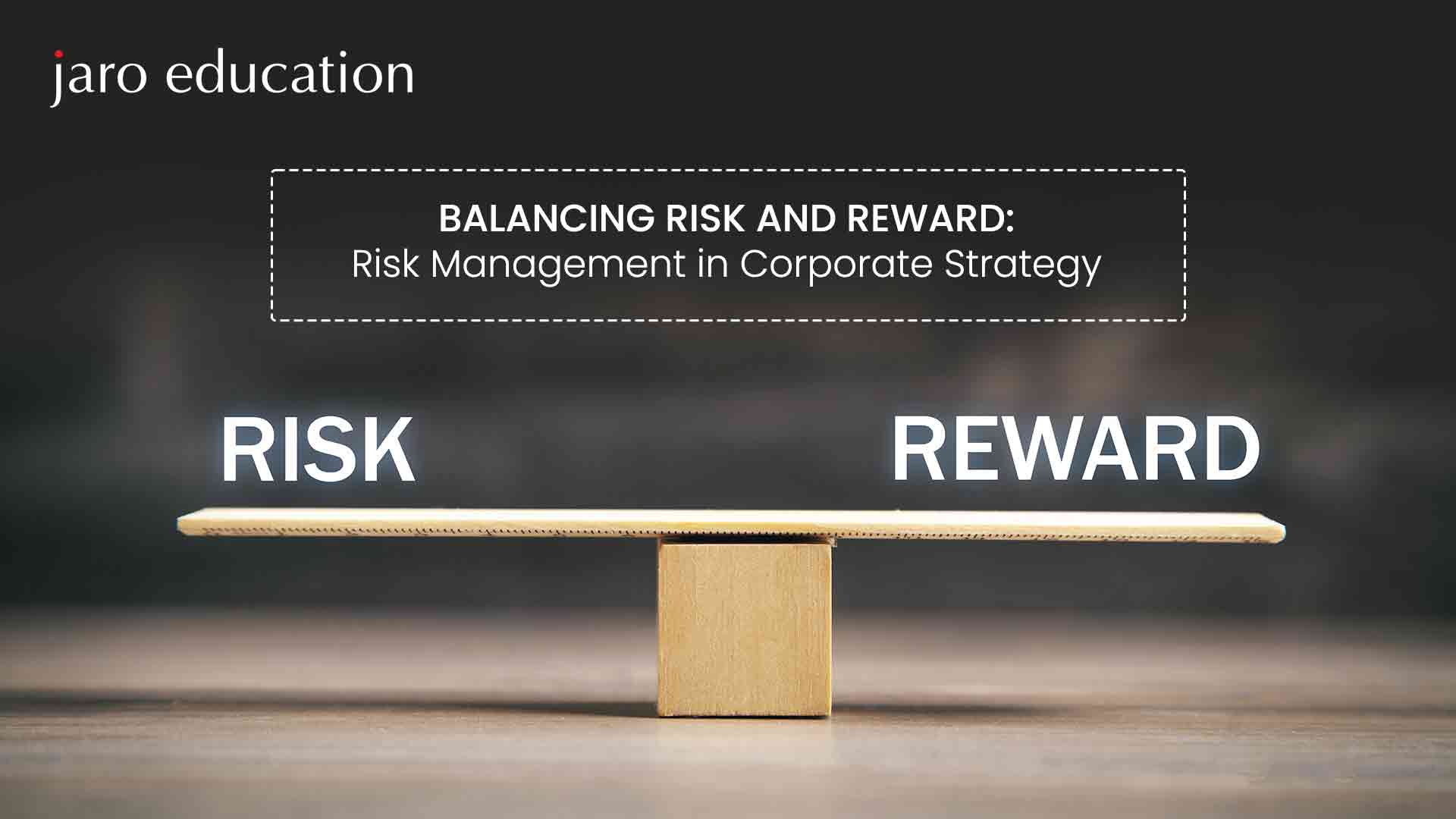Balancing Risk and Reward: Risk Management in Corporate Strategy
Table of Contents

- jaro education
- 13, January 2024
- 9:00 am
In the complex world of business, understanding risk management is akin to having a well-thought-out plan to safeguard your ship from potential storms. It involves identifying potential issues, gauging their potential impact, and devising strategies to minimize risks.
According to Forrester, 41% of organizations disclosed encountering three or more critical risk events in the past year. For any organization, risk management isn’t just a safety measure; it’s a fundamental aspect of ensuring smooth operations. With rules and risks in constant flux, professionals like auditors and risk managers become instrumental in maintaining low risks. They handle everything from supply chain challenges to navigating the uncharted territories of new technologies.
Every member of an organization plays a role in managing risks, and having clear and comprehensible methods is crucial. Think of it as having a shared language that unites everyone, ensuring a consistent approach to thinking about and dealing with risks.
What is Risk Management?
Understanding risk management is like having a plan to keep your business safe from potential problems. It involves figuring out what could go wrong, deciding how bad it could be, and coming up with ways to reduce the chances of those bad things happening.
For any organization, risk management is a crucial part of making sure everything runs smoothly. With rules and risks changing all the time, people who check for problems and risks (like auditors and risk professionals) are really important. They help to make sure that the business is doing things to keep risks low, whether it’s dealing with supply chain issues or considering things like the environment and new technologies.
Everyone in the organization plays a part in managing risks, so it’s important to have clear methods that everyone can understand. This helps everyone work together and make sure they’re all thinking about risks in the same way. It’s kind of like having a common language for understanding and talking about risks.
For those seeking to enhance their expertise in strategic management, the “Professional Certificate Program in Strategic Management” by IIM Kozhikode offers a comprehensive avenue. This course equips individuals with the tools and insights required to navigate the intricate landscape of strategic decision-making, seamlessly aligning with the ethos of effective risk management.
Types of Risk Management
Handling the different kinds of risks that can impact an organization is part of risk management. These are a few typical approaches to risk management.
1. Operational Risk Management
In this aspect, risks that are inherent to daily operations are carefully assessed and mitigated. Operational risk management works to guarantee the core smooth operation of an organization, from internal procedures to possible external disruptions.
Example: A manufacturing business notices that equipment failures could pose an operational risk to its production line. To avoid that, it invests in backup equipment to reduce downtime and has a preventive maintenance schedule in place to reduce this risk.
2. Compliance Risk Management
A proactive approach to guaranteeing that organizations follow the law, rules, and industry standards. Businesses reduce legal and regulatory risks and create a stable and safe operating environment by proactively addressing compliance.
Example: A financial institution ensures AML compliance by implementing stringent customer due diligence processes, transaction monitoring systems, and regular audits to detect and prevent potential noncompliance.
3. IT Risk Management
This kind of risk management takes into account the ever-changing landscape of technology-related risks in an era where technological advancements are paramount. An organization’s digital infrastructure is protected by IT risk management from cybersecurity threats to data integrity.
Example: Cybersecurity threats pose a threat to a technology company. It invests in advanced cybersecurity tools, conducts regular vulnerability assessments, and educates employees on best practices for avoiding phishing attacks to manage this risk.
4. Third-Party Risk Management
This type of risk management concentrates on the dangers connected to suppliers, vendors, and outside partnerships. Maintaining a robust and secure business ecosystem requires regular evaluation of the dependability, security, and overall impact of these relationships.
Example: An e-commerce company gets its inventory from third-party vendors. To reduce the risk of supply chain disruptions, the company diversifies its supplier base, establishes strong contractual agreements, and closely monitors each supplier’s performance.
5. Enterprise Risk Management (ERM)
ERM covers the entire organization from an organizational standpoint. The strategic risk management section of ERM investigates risks that may have an impact on long-term organizational objectives and provides a comprehensive approach to risk mitigation.
Example: An international corporation is thinking about entering a new market. As part of ERM, the company conducts a thorough risk assessment, taking into account political, economic, and cultural factors in order to make informed market entry decisions.
6. Financial Risk Management
Financial risk management covers risks associated with financial activities, such as credit factors, market dynamics, and liquidity issues. The organization’s financial stability and long-term growth are guaranteed by a strong financial risk management strategy.
Example: A hedge fund manages market risk by diversifying its investment portfolio across various asset classes. This diversification helps to mitigate the impact of market fluctuations on the fund’s overall financial performance.
7. Strategic Risk Management
Strategic risk management recognizes and manages risks associated with long-term strategic goals. Strategic risk management readies companies for future challenges through the analysis of market shifts, competition dynamics, and broader business environmental changes.
Example: An automotive company faces strategic risk as consumer preferences for electric vehicles shift. To mitigate this risk, the company invests in research and development to develop competitive electric vehicle offerings.
8. Reputational Risk Management
Reputational risk management safeguards reputation, an intangible but priceless asset. The foundation of reputational risk management is maintaining stakeholder trust through effective crisis communication and actions that are in line with organizational values.
Example: A food and beverage company responds to a product recall in a transparent and proactive manner, promptly communicating with customers, conducting thorough investigations, and implementing enhanced quality control measures to protect its reputation.
9. Supply Chain Risk Management
Supply chain risk management controls the risks posed by the complex supply chain network. Maintaining a robust and effective supply chain operation requires addressing possible delays, disruptions, and reliance on important suppliers.
Example: An electronics manufacturer sources a critical component from a specific region. To manage the risk of supply chain disruptions caused by geopolitical events, the company diversifies its suppliers and maintains strategic inventory reserves.
10. Project Risk Management
Project-specific risks such as budgetary considerations, potential delays, and scope changes were highlighted. A well-executed project risk management strategy is critical to completing initiatives within defined parameters.
Example: A construction company working on a large infrastructure project recognizes the possibility of weather-related delays. The project plan includes flexible timelines to mitigate this risk, and the company monitors weather forecasts to adjust work schedules accordingly.
What is the Importance of Risk Management?
Risk management is critical for organizations because it protects them from potential threats that could harm their reputation, financial stability, and compliance with a wide range of laws and regulations, from local statutes to global mandates.
Risk management is, at its core, a strategic tool that enables organizations to comprehensively identify and mitigate potential risks. These threats can take many forms, including data protection and privacy, cybersecurity, financial crime, and others. A well-crafted risk management plan acts as a dynamic framework, addressing new challenges as they arise.
The dynamic nature of the business environment necessitates a constant and rigorous risk assessment. An effective risk management strategy must adapt to an ever-changing risk landscape in order to remain relevant in the face of changing circumstances and emerging threats.
Importantly, the success of a risk management plan is dependent on its accessibility and comprehension throughout the organization. The plan should not be limited to a few but should be widely disseminated, providing both employees and leadership with the critical information needed to make timely, informed, and risk-aware decisions. This collaborative approach ensures that the entire organization is working together to effectively identify, assess, and mitigate risks.
Risk Management Trends to Look for in 2024
Here are pivotal trends that executives and risk professionals should closely track in 2024.

*mindflow.io
Artificial Intelligence (AI) and Machine Learning (ML)
AI and machine learning are at the forefront of a transformative wave in risk management, bringing sophisticated analytics capabilities. These game-changing technologies enable businesses to delve into massive datasets, uncover intricate patterns, and derive actionable insights for data-driven decision-making.
AI and ML algorithms proficiently evaluate risks in real-time, quickly identify anomalies, and streamline risk assessment processes. As a result, there is a greater level of efficiency and precision in risk management, indicating a significant evolution in best practices.
Cybersecurity
In today’s digital age, keeping things secure online is essential for managing risks effectively. Organizations face increasing threats like cyber attacks, data breaches, and information vulnerabilities. To protect valuable assets such as sensitive data, intellectual property, and customer information, strong cybersecurity measures are a must.
Advanced technologies like threat intelligence, encryption, and behavioral analytics play a pivotal role in identifying and mitigating these cyber risks, offering a proactive defense against evolving threats. Embracing these cybersecurity measures is essential to ensure a secure digital environment and protect critical assets in our interconnected world.
Big Data Analytics
In risk management, the copious amounts of data generated by organizations open doors to both possibilities and complexities. Big data analytics emerges as a transformative force, enabling organizations to extract meaningful insights from a variety of structured and unstructured data sources. This analytical ability allows for the proactive identification of potential risks, a thorough assessment of their impact, and the development of tailored risk mitigation strategies.
Organizations gain the ability to anticipate and comprehend risks by delving into the patterns and correlations within data. This proactive approach is critical in avoiding potential problems. Furthermore, big data analytics improves risk management‘s predictive capabilities, allowing organizations to make well-informed decisions and optimize their risk strategies for maximum effectiveness.
Risk Governance
Risk governance is a critical concept for efficient operations. It entails establishing clear rules—frameworks, policies, and procedures—that serve as the foundation of a strong risk management system. Organizations must take a proactive approach to risk governance as risks evolve.
Being proactive entails not only developing risk management strategies that align with organizational objectives, but also cultivating a culture of risk awareness at all levels. It also includes seamlessly integrating risk considerations into decision-making processes, ensuring that risk factors are woven into strategic decisions across the organizational hierarchy.
For those seeking to stay ahead in this rapidly evolving landscape, IIM Kozhikode offers the “Professional Certificate Program in Strategic Management.” This course equips individuals with the insights and skills necessary to navigate the complexities of strategic decision-making, aligning seamlessly with the cutting-edge trends shaping the future of risk management.
Conclusion
In the business landscape, risk management stands as a strategic guide, helping organizations navigate uncertainties. As we explore various types of risk management, from operational to strategic, it becomes clear that a well-rounded approach is necessary to shield against potential issues.
The significance of risk management is paramount—it’s a proactive tool that shields organizations from reputational damage, financial instability, and legal challenges. Looking ahead, trends like AI and ML, cybersecurity, big data analytics, and risk governance emerge as pivotal forces shaping risk management in 2024. Embracing these trends ensures organizations not only weather uncertainties but also set sail confidently toward their strategic goals.








